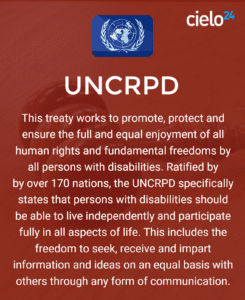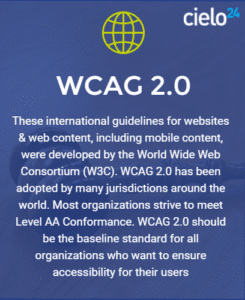EU Web Accessibility Laws and Policies There are 3 main EU web accessibility laws and…

Australian Web Accessibility Laws and Policies
Australian Web Accessibility Laws and Policies
There are over 450,000 Australians who have vision impairments and over 2 million who have hearing disabilities. In 2001, 98% of websites failed to meet the W3C’s Web Content Accessibility Guidelines 2.0. Luckily, a progression in Australian web accessibility laws and policies have set Australians up for a more accessible future.
Disability Discrimination Act 1992
The main Australian website accessibility law is the Disability Discrimination Act 1992, which requires equal access for people with disabilities.
This requirement applies to any individual or organisation developing a website or other web resource in Australia or placing or maintaining a web resource on an Australian server.
It includes web pages and other resources developed or maintained for purposes related to employment; education; provision of services including professional services, banking, insurance or financial services, entertainment or recreation, telecommunications services, public transport services, or government services; sale or rental of real estate; sport; activities of voluntary associations; or administration of Commonwealth laws and programs.
As per Section 5 of the law, inaccessible web content discriminates against people with disabilities by treating them “less favourably” than those without a disability. Additionally, refusing to make a “reasonable adjustment” to a website so that its content is accessible to someone with a disability is viewed as discrimination.
The most notable example of legal action under the DDA for web accessibility discrimination occurred in 2000 with the case Bruce Lindsay Maguire v Sydney Organising Committee for the Olympic Games. Maguire, who is blind, issued a complaint that he was unlawfully discriminated against by the Sydney Organising Committee for the Olympic Games (SOCOG) in three ways:
- The failure to provide braille copies of the information required to place orders for Olympic Games tickets
- The failure to provide braille copies of the Olympic Games souvenir program
- The failure to provide a website which was accessible to the complainant
In their review of the website’s accessibility based on WCAG standards, the Commissioner found that Maguire had indeed been treated less favourably by the SOCOG:
At the time of the making of the complaint and at the time of his statement of 29 April 2000, the complainant was clearly the recipient of less favourable treatment by the respondent in that he was unable to access the services offered by the respondent by means of its web site or at best he was offered imperfect or limited access only because of the manner in which the services were made available and this less favourable treatment was because of his disability.
The Sydney Organising Committee was ordered to make its website accessible including ALT text on all images and image map links on its website. It also had to provide access to both the Index of Sports from the Schedule page and the Results Tables. If SOCOG fialed to comply with that order, Maguire would have the option to press for compensation.
United Nations’ Convention on the Rights of Persons with Disabilities

In 2008, Australian web accessibility was bolstered by the ratification the United Nations’ Convention on the Rights of Persons with Disabilities.
Article 21 states that States Parties must ensure that people with disabilities can exercise their right to freedom of expression and opinion. This includes the freedom to seek, receive and impart information and ideas on an equal basis with others through all forms of communication of their choice. Requirements include:
- Providing information in accessible formats and technologies appropriate to different kinds of disabilities in a timely manner and without additional cost
- Accepting and facilitating the use of sign languages, Braille, augmentative and alternative communication, and all other accessible means, modes and formats of communication of their choice by persons with disabilities in official interactions
- Urging private entities that provide services to the general public, including through the Internet, to provide information and services in accessible and usable formats for persons with disabilities
- Encouraging the mass media, including providers of information through the Internet, to make their services accessible to persons with disabilities
- Recognizing and promoting the use of sign languages
The ratification of the UNCRPD means that Australia is obligated to implement policies and practices that are consistent with Convention’s commitment to asserting “the right of people with a disability to participate fully and independently in all aspects of society, including the internet and access to information.”
National Transition Strategy
The major piece of policy supporting Australian web accessibility is the National Transition Strategy, or NTS.
In 2009, the Secretaries’ ICT Governance Board endorsed the Australian Government’s transition to WCAG 2.0. This required all Australian Government websites to implement WCAG 2.0 Level AA Conformance over a four-year period. The NTS set forth a strategy and three-phase work plan for implementing WCAG 2.0 by 2014.
This Australian web accessibility policy states that WCAG 2.0 is applicable to all online government information and services, including all internet, intranet and extranet sites. Furthermore, “Agencies that do not implement WCAG 2.0 for their intranet must accept they may be at greater risk of complaint under the Disability Discrimination Act 1992 and other anti-discrimination Acts.”

The Web Content Accessibility Guidelines were created around the following 4 principles:
- Perceivable
- Provide text alternatives for non-text content
- Provide captions and other alternatives for multimedia
- Create content that can be presented in different ways, including by assistive technologies, without losing meaning
- Make it easier for users to see and hear content
- Operable
- Make all functionality available from a keyboard
- Give users enough time to read and use content
- Do not use content that causes seizures
- Help users navigate and find content
- Understandable
- Make text readable and understandable
- Make content appear and operate in predictable ways
- Help users avoid and correct mistakes.
- Robust
- Maximize compatibility with current and future user tools.
WCAG 2.0 covers an extensive range of recommendations that each have a success criteria factor ranging from Level A to AAA. For example, section 1.2.2 and 1.2.3 (Level A) require that all audio and video content have synchronized captions as well as an audio description or media alternative. You can view the complete guidelines here.
While the NTS requires WCAG 2.0 level AA compliance for all government websites, agencies can choose for themselves if their user base requires a higher level of compliance.
Although many businesses view the NTS as only applying to Australian Government sites, it should really by be viewed as a standard for all organisations, whether they are in government, business, education, etc. This is due to the fact that all organizations are equally subject to the Disability Discrimination Act 1992 and other anti-discrimination Acts if any of their websites are inaccessible.
Conclusion
Australia has made great strides in establishing Australian web accessibility across all industries. The DDA requires equal access for people with disabilities to websites and web content, and past cases such as Bruce Lindsay Maguire v Sydney Organising Committee for the Olympic Games have solidified this.
We hope that a shift in thinking about accessibility from something that would be nice to have at some point to something that is the right thing to do as well as required by law, will help accelerate the push towards Australian web accessibility,
As Jakob Nielsen, a widely regarded website usability expert, writes:
As long as companies and government agencies view accessibility as solely a matter of complying with regulations and technical specifications, rather than a way to support the work practices and customer needs of people with disabilities, equal opportunity will remain a travesty. Websites and intranets must follow usability principles and make it easier for customers and employees with disabilities to perform their tasks.



